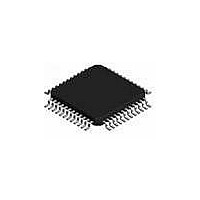MC68908GZ8MFAE Freescale Semiconductor, MC68908GZ8MFAE Datasheet - Page 246

MC68908GZ8MFAE
Manufacturer Part Number
MC68908GZ8MFAE
Description
IC MCU 8BIT 8K FLASH 48-LQFP
Manufacturer
Freescale Semiconductor
Series
HC08r
Datasheet
1.MC68908GZ8CFJER.pdf
(314 pages)
Specifications of MC68908GZ8MFAE
Core Processor
HC08
Core Size
8-Bit
Speed
8MHz
Connectivity
CAN, LIN, SCI, SPI
Peripherals
LVD, POR, PWM
Number Of I /o
37
Program Memory Size
8KB (8K x 8)
Program Memory Type
FLASH
Ram Size
1K x 8
Voltage - Supply (vcc/vdd)
3 V ~ 5.5 V
Data Converters
A/D 8x10b
Oscillator Type
Internal
Operating Temperature
-40°C ~ 125°C
Package / Case
48-LQFP
Processor Series
M689xx
Core
HC08
Data Bus Width
8 bit
Data Ram Size
1 KB
Interface Type
SPI, SCI, CAN
Maximum Clock Frequency
8 MHz
Number Of Programmable I/os
37
Number Of Timers
2
Operating Supply Voltage
5.5 V
Maximum Operating Temperature
+ 125 C
Mounting Style
SMD/SMT
Development Tools By Supplier
FSICEBASE, M68CBL05AE, DEMO908GZ60E, M68EML08GZE
Minimum Operating Temperature
- 40 C
On-chip Adc
10 bit, 16 Channel
Lead Free Status / RoHS Status
Lead free / RoHS Compliant
Eeprom Size
-
Lead Free Status / Rohs Status
Details
- Current page: 246 of 314
- Download datasheet (5Mb)
Serial Peripheral Interface (SPI) Module
17.12.2 MOSI (Master Out/Slave In)
MOSI is one of the two SPI module pins that transmits serial data. In full-duplex operation, the MOSI pin
of the master SPI module is connected to the MOSI pin of the slave SPI module. The master SPI
simultaneously transmits data from its MOSI pin and receives data on its MISO pin.
When enabled, the SPI controls data direction of the MOSI pin regardless of the state of the data direction
register of the shared I/O port.
17.12.3 SPSCK (Serial Clock)
The serial clock synchronizes data transmission between master and slave devices. In a master MCU,
the SPSCK pin is the clock output. In a slave MCU, the SPSCK pin is the clock input. In full-duplex
operation, the master and slave MCUs exchange a byte of data in eight serial clock cycles.
When enabled, the SPI controls data direction of the SPSCK pin regardless of the state of the data
direction register of the shared I/O port.
17.12.4 SS (Slave Select)
The SS pin has various functions depending on the current state of the SPI. For an SPI configured as a
slave, the SS is used to select a slave. For CPHA = 0, the SS is used to define the start of a transmission.
(See
toggled high and low between each byte transmitted for the CPHA = 0 format. However, it can remain low
between transmissions for the CPHA = 1 format. See
When an SPI is configured as a slave, the SS pin is always configured as an input. It cannot be used as
a general-purpose I/O regardless of the state of the MODFEN control bit. However, the MODFEN bit can
still prevent the state of the SS from creating a MODF error. See
When an SPI is configured as a master, the SS input can be used in conjunction with the MODF flag to
prevent multiple masters from driving MOSI and SPSCK. (See
the SS pin to set the MODF flag, the MODFEN bit in the SPSCK register must be set. If the MODFEN bit
is low for an SPI master, the SS pin can be used as a general-purpose I/O under the control of the data
direction register of the shared I/O port. With MODFEN high, it is an input-only pin to the SPI regardless
of the state of the data direction register of the shared I/O port.
246
17.5 Transmission
A logic 1 voltage on the SS pin of a slave SPI puts the MISO pin in a
high-impedance state. The slave SPI ignores all incoming SPSCK clocks,
even if it was already in the middle of a transmission.
MASTER SS
MISO/MOSI
SLAVE SS
SLAVE SS
CPHA = 0
CPHA = 1
Formats.) Since it is used to indicate the start of a transmission, the SS must be
MC68HC908GZ16 • MC68HC908GZ8 Data Sheet, Rev. 4
Figure 17-13. CPHA/SS Timing
BYTE 1
NOTE
Figure
BYTE 2
17-13.
17.7.2 Mode Fault Error.)
17.13.2 SPI Status and Control Register.
BYTE 3
Freescale Semiconductor
For the state of
Related parts for MC68908GZ8MFAE
Image
Part Number
Description
Manufacturer
Datasheet
Request
R
Part Number:
Description:
Manufacturer:
Freescale Semiconductor, Inc
Datasheet:
Part Number:
Description:
Manufacturer:
Freescale Semiconductor, Inc
Datasheet:
Part Number:
Description:
Manufacturer:
Freescale Semiconductor, Inc
Datasheet:
Part Number:
Description:
Manufacturer:
Freescale Semiconductor, Inc
Datasheet:
Part Number:
Description:
Manufacturer:
Freescale Semiconductor, Inc
Datasheet:
Part Number:
Description:
Manufacturer:
Freescale Semiconductor, Inc
Datasheet:
Part Number:
Description:
Manufacturer:
Freescale Semiconductor, Inc
Datasheet:
Part Number:
Description:
Manufacturer:
Freescale Semiconductor, Inc
Datasheet:
Part Number:
Description:
Manufacturer:
Freescale Semiconductor, Inc
Datasheet:
Part Number:
Description:
Manufacturer:
Freescale Semiconductor, Inc
Datasheet:
Part Number:
Description:
Manufacturer:
Freescale Semiconductor, Inc
Datasheet:
Part Number:
Description:
Manufacturer:
Freescale Semiconductor, Inc
Datasheet:
Part Number:
Description:
Manufacturer:
Freescale Semiconductor, Inc
Datasheet:
Part Number:
Description:
Manufacturer:
Freescale Semiconductor, Inc
Datasheet:
Part Number:
Description:
Manufacturer:
Freescale Semiconductor, Inc
Datasheet:










